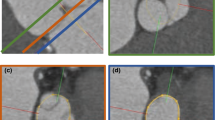Abstract
Valve annuli motion and morphology, measured from non-invasive imaging, can be used to gain a better understanding of healthy and pathological heart function. Measurements such as long-axis strain as well as peak strain rates provide markers of systolic function. Likewise, early and late-diastolic filling velocities are used as indicators of diastolic function. Quantifying global strains, however, requires a fast and precise method of tracking long-axis motion throughout the cardiac cycle. Valve landmarks such as the insertion of leaflets into the myocardial wall provide features that can be tracked to measure global long-axis motion. Feature tracking methods require initialisation, which can be time-consuming in studies with large cohorts. Therefore, this study developed and trained a neural network to identify ten features from unlabeled long-axis MR images: six mitral valve points from three long-axis views, two aortic valve points and two tricuspid valve points. This study used manual annotations of valve landmarks in standard 2-, 3- and 4-chamber long-axis images collected in clinical scans to train the network. The accuracy in the identification of these ten features, in pixel distance, was compared with the accuracy of two commonly used feature tracking methods as well as the inter-observer variability of manual annotations. Clinical measures, such as valve landmark strain and motion between end-diastole and end-systole, are also presented to illustrate the utility and robustness of the method.
Access this chapter
Tax calculation will be finalised at checkout
Purchases are for personal use only
Similar content being viewed by others
References
Bengio, Y., Louradour, J., Collobert, R., Weston, J.: Curriculum learning. In: International Conference on Machine Learning, pp. 41–48. Association for Computing Machinery, New York (2009)
Berger, L., Eoin, H., Cardoso, M.J., Ourselin, S.: An adaptive sampling scheme to efficiently train fully convolutional networks for semantic segmentation. In: Nixon, M., Mahmoodi, S., Zwiggelaar, R. (eds.) MIUA 2018. CCIS, vol. 894, pp. 277–286. Springer, Cham (2018). https://doi.org/10.1007/978-3-319-95921-4_26
Bhatnagar, P., Wickramasinghe, K., Wilkins, E., Townsend, N.: Trends in the epidemiology of cardiovascular disease in the UK. Heart 102(24), 1945–1952 (2016)
Brecker, S.J.D.: The importance of long axis ventricular function. Heart 84, 577–578 (2000)
Bulluck, H., et al.: A simple technique to measure TAPSE and MAPSE on CMR and normal values. JCMR 16(S1), 1–2 (2014)
Fonseca, C.G., et al.: The cardiac atlas project-an imaging database for computational modeling and statistical atlases of the heart. Bioinformatics 27(16), 2288–2295 (2011)
Grewal, J., et al.: Mitral annular dynamics in myxomatous valve disease: new insights with real-time 3-dimensional echocardiography. Circulation 121(12), 1423–1431 (2010)
Huang, G., Liu, Z., Weinberger, K.Q.: Densely connected convolutional networks. In: Proceedings of the IEEE Conference on Computer Vision and Pattern Recognition (2017)
Hung, C.L., et al.: Longitudinal and circumferential strain rate, LV remodeling, and prognosis after myocardial infarction. J. Am. Coll. Cardiol. 56(22), 1812–1822 (2010)
Ionasec, R.I., et al.: Patient-specific modeling and quantification of the aortic and mitral valves from 4D cardiac CT and TEE. IEEE Trans. Med. Imaging 29(9), 1636–1651 (2010)
de Kerchove, L., et al.: The role of annular dimension and annuloplasty in tricuspid aortic valve repair. Eur. J. Cardiothorac. Surg. 49(2), 428–437 (2016). https://doi.org/10.1093/ejcts/ezv050. discussion 437–8
Kingma, D.P., Ba, J.: Adam: a method for stochastic optimization. In: 3rd International Conference on Learning Representations, pp. 1–15 (2014)
Leng, S., et al.: Imaging 4D morphology and dynamics of mitral annulus in humans using cardiac cine MR feature tracking. Sci. Rep. 8(1), 81 (2018)
Leng, S., Tan, R.-S., Zhao, X., Allen, J.C., Koh, A.S., Zhong, L.: Fast long-axis strain: a simple, automatic approach for assessing left ventricular longitudinal function with cine cardiovascular magnetic resonance. Eur. Radiol. 30(7), 3672–3683 (2020). https://doi.org/10.1007/s00330-020-06744-6
Schuh, A., et al.: Construction of a 4D brain atlas and growth model using diffeomorphic registration. In: Durrleman, S., Fletcher, T., Gerig, G., Niethammer, M., Pennec, X. (eds.) STIA 2014. LNCS, vol. 8682, pp. 27–37. Springer, Cham (2015). https://doi.org/10.1007/978-3-319-14905-9_3
Schuster, A., et al.: Cardiovascular magnetic resonance feature-tracking assessment of myocardial mechanics: intervendor agreement and considerations regarding reproducibility. Clin. Radiol. 70(9), 989–998 (2015)
Schuster, A., Hor, K.N., Kowallick, J.T., Beerbaum, P., Kutty, S.: Cardiovascular magnetic resonance myocardial feature tracking: concepts and clinical applications. Circ. Cardiovasc. Imaging 9(4), 1–9 (2016)
Tomasi, C., Kanade, T.: Detection and tracking of point features. Technical report (1991)
Yushkevich, P.A., et al.: User-guided 3D active contour segmentation of anatomical structures: significantly improved efficiency and reliability. Neuroimage 31(3), 1116–1128 (2006)
Acknowledgements
This research was supported by the Wellcome EPSRC Centre for Medical Engineering at the School of Biomedical Engineering and Imaging Sciences, King’s College London (WT 203148/Z/16/Z).
Author information
Authors and Affiliations
Corresponding author
Editor information
Editors and Affiliations
Rights and permissions
Copyright information
© 2021 Springer Nature Switzerland AG
About this paper
Cite this paper
Kerfoot, E., King, C.E., Ismail, T., Nordsletten, D., Miller, R. (2021). Estimation of Cardiac Valve Annuli Motion with Deep Learning. In: Puyol Anton, E., et al. Statistical Atlases and Computational Models of the Heart. M&Ms and EMIDEC Challenges. STACOM 2020. Lecture Notes in Computer Science(), vol 12592. Springer, Cham. https://doi.org/10.1007/978-3-030-68107-4_15
Download citation
DOI: https://doi.org/10.1007/978-3-030-68107-4_15
Published:
Publisher Name: Springer, Cham
Print ISBN: 978-3-030-68106-7
Online ISBN: 978-3-030-68107-4
eBook Packages: Computer ScienceComputer Science (R0)





